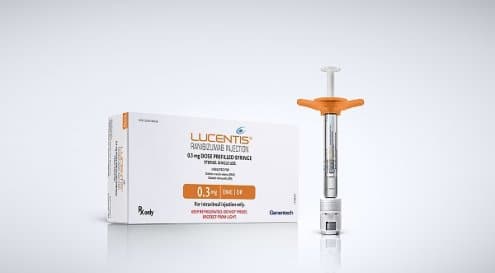What is Lucentis (Ranibizumab)?
Lucentis is a medication that is used to treat a variety of eye and vision disorders that may be related to diabetic retinopathy. As diabetes progresses, damage to the eyes and vision may occur. Ranibizumab is part of a class of drugs called VEGF-A inhibitors which prevent blood vessel growth; this process has been linked to eye conditions and treatment with drugs like Lucentis can stabilize this phenomenon.
What does this medication do?
Lucentis eye injections are used to treat several eye conditions related to diabetes, including neovascular (wet) age-related macular degeneration (AMD); visual impairment due to diabetic macular edema (DME); visual impairment due to macular edema secondary to retinal vein occlusion (RVO); and visual impairment due to choroidal neovascularization (CNV) secondary to pathologic myopia (PM).
Who makes Lucentis?
Lucentis is produced by the company Genentech, which is located in San Francisco.
How does Ranibizumab work?
Lucentis is not for home administration because it is only available as a suspension for intravitreal injection, i.e. for injection into the eye. Ranibizumab must therefore be administered by a qualified ophthalmologist who is experienced in delivering intravitreal injections.
Injections are typically available in a single-use vial or in a single-use, prefilled syringe. Vials or pre-filled syringes of Lucentis must not be re-used because of the risk of infection.
How to store the drug
Store Lucentis in a refrigerator at between 2 and 8 degrees Celsius. Protect the vial and/or pre-filled syringe from light, heat and dampness.
Lucentis side effects
Lucentis is generally well-tolerated. The most serious adverse effects as reported in a large-scale clinical trial are ophthalmologic in nature and include endophthalmitis, rhegmatogenous retinal detachment, retinal tear and iatrogenic traumatic cataract.
Common side effects
- Dry eye
- Eye irritation
- Eye pain
Severe side effects
- Cataract
- Conjunctival hemorrhage
- Detachment of retinal pigment
Dosage
The recommended dosage of Lucentis is 0.5 mg administered by intravitreal injection once per month. If monthly dosing is not feasible, the treatment regimen may be adjusted to one injection every three months, although a loss of visual acuity may occur if treatment frequency is decreased.
Treatment with Ranibizumab is generally initiated via a loading phase consisting of one injection per month for three consecutive months. This is followed by a maintenance phase in which patients should be monitored closely for changes in visual acuity. If there is evidence that Lucentis is not working effectively during the maintenance phase, the dosage frequency may be increased again.
Who should not take it
Patients with periocular or ocular infections or who are hypersensitive to any of the medication’s ingredients should not take Lucentis.
Doctor’s Recommendation
This article is an excellent example of why prevention through a ketogenic diet and proper glucose management is better than dealing with complications. The medicines are costly, and receiving specialized laser therapy from an ophthalmologist is not cheap either. Diabetic retinopathy management can only be done by an ophthalmologist as every patient is unique and requires a nuanced and individualized approach. This article places an option on the table for a patient to bring up to their ophthalmologist.



